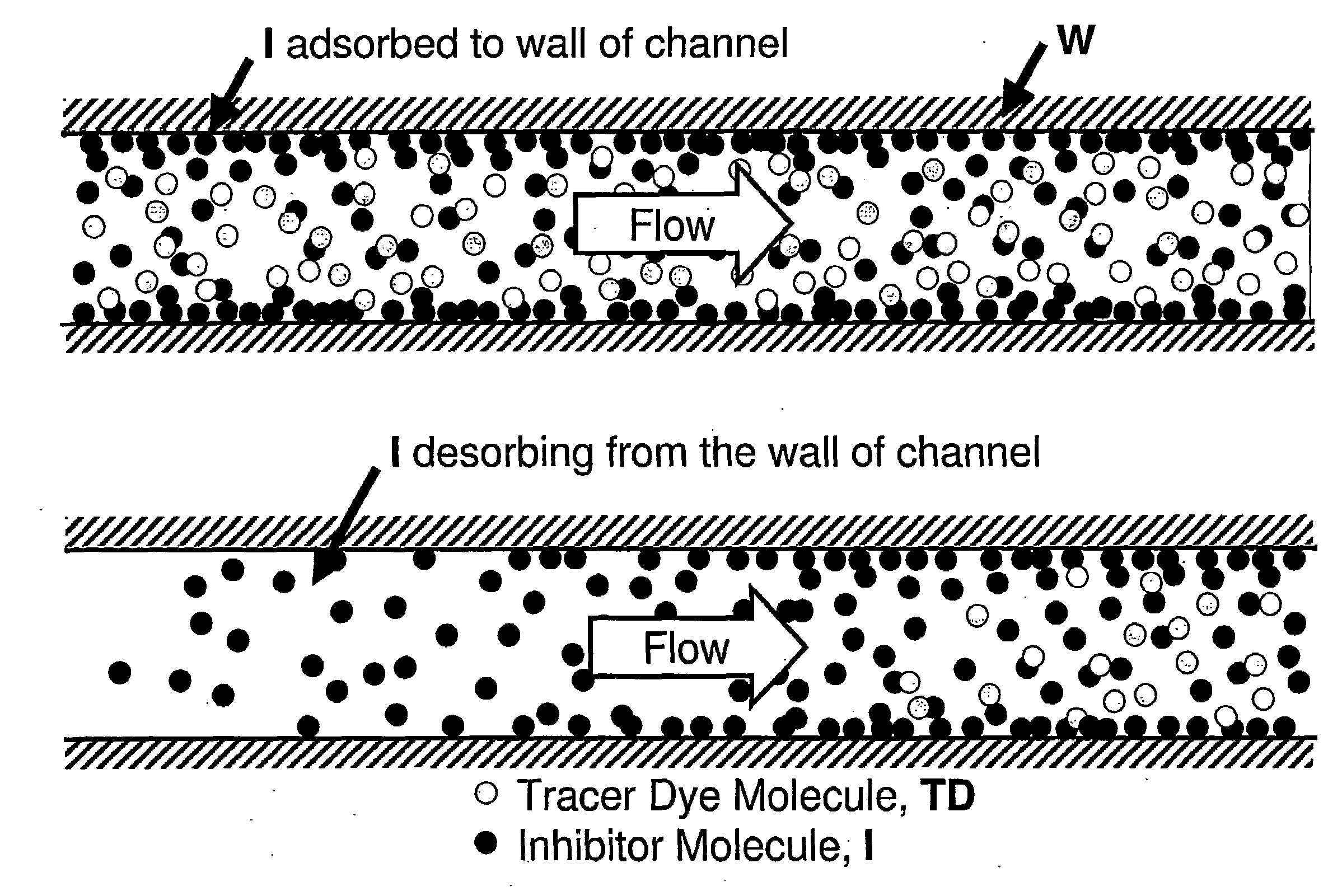Plastic surfaces and apparatuses for reduced adsorption of solutes and methods of preparing the same
a technology applied in the field of plastic surfaces and apparatuses for reducing adsorption of solutes and methods of preparing the same, can solve the problems of high cost and labor intensity of photolithography and etching techniques, cost and time savings, and require clean-room conditions, so as to achieve less likely to adsorb and more hydrophilic
- Summary
- Abstract
- Description
- Claims
- Application Information
AI Technical Summary
Benefits of technology
Problems solved by technology
Method used
Image
Examples
example 1
Dependence of Surface Hydrophilicity on Fluorination Time
[0198]A flat piece of polycarbonate (formed from a CALIBRE™ 200 series resin, Dow Chemicals, Wilmington, Del., USA) was treated according to the method of the following steps:[0199](1) the surface was flushed with air for about 1 minute;[0200](2) the surface was placed in a vacuum for about 1 minute;[0201](3) the surface was flushed with a fluorine gas mixture containing 5% fluorine and 95% neon for a period of time;[0202](4) the surface was flushed with air for about 1 minute; and[0203](5) the surface was placed in a vacuum for about 1 minute.
[0204]FIG. 5 shows the contact angle between water and the treated polycarbonate for polycarbonate samples treated with the fluorine gas mixture for different periods of time. As can be seen in FIG. 5 at time 0, the contact angle of untreated polycarbonate is about 55, indicating that it is hydrophobic, but not as hydrophobic as, for example, TEFLON®. After approximately 2½ minutes, the ...
example 2
IC50 Determination Using a Non-Treated SPA
[0205]FIG. 6 shows the results of a typical experiment to measure IC50 using a sample processing apparatus SPA as depicted in FIG. 2. The pumps contained the following:[0206]PA: inhibitor+tracer dye (ALEXA FLUOR 700™, Invitrogen, Carlsbad, Calif., USA)+enzyme substrate+buffer[0207]PB: enzyme substrate+buffer[0208]PC: coupling enzymes+target enzyme+resazurin (also from Invitrogen)
The tracer dye is added to the solution containing the inhibitor such that measurement of the concentration of ALEXA FLUOR 700™ in the solution reports the concentration of the inhibitor, so long as the inhibitor does not adsorb to the walls of the microfluidic chip. If adsorption occurs, the concentration of the inhibitor will vary in expected ways, as discussed below. Resazurin is a non-fluorescent precursor that is converted to highly fluorescent resorufin by the action of the target enzyme and the coupling enzymes. The pump flow rates varied as follows:
1300 to 13...
example 3
IC50 Determination Using a Treated SPA
[0212]FIG. 9 shows the data from an experiment identical to that described above in Example 2, with the exception that the experiment whose data is reported in FIG. 9 was performed in a microfluidic chip that had been treated by the method of the presently disclosed subject matter. The upper graph of FIG. 9 is the data from FIG. 6 redrawn for ease of comparison. The lower graph is data from the experiment in treated microfluidic chip MFC. Most notably, enzyme plot EP in the lower graph rises to full activity more quickly than in the upper graph, indicating that the inhibitor concentration decreases more quickly, as expected if adsorption has been reduced in the experiment for the lower graph.
[0213]FIG. 10 presents the data from the lower graph of FIG. 9 transformed to concentration versus enzyme activity to determine the inhibitor's IC50. The x-axis is the concentration of the inhibitor, as reported by the tracer dye, which is tracer plot TP in ...
PUM
 Login to View More
Login to View More Abstract
Description
Claims
Application Information
 Login to View More
Login to View More - R&D
- Intellectual Property
- Life Sciences
- Materials
- Tech Scout
- Unparalleled Data Quality
- Higher Quality Content
- 60% Fewer Hallucinations
Browse by: Latest US Patents, China's latest patents, Technical Efficacy Thesaurus, Application Domain, Technology Topic, Popular Technical Reports.
© 2025 PatSnap. All rights reserved.Legal|Privacy policy|Modern Slavery Act Transparency Statement|Sitemap|About US| Contact US: help@patsnap.com



